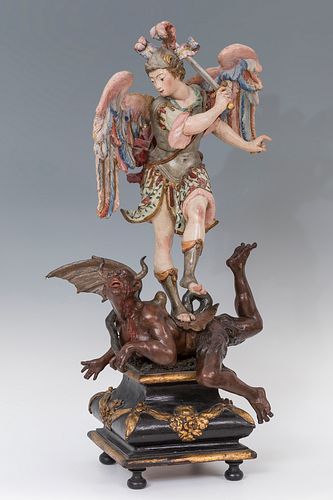Colonial school; XVIII century. "San Miguel". Carved and polychrome wood.
Lot 8
About Seller
Setdart Auction House
Carrer Aragó 346
Barcelona
Spain
Setdart Subastas was born in 2004 and is currently the first online art auction in Spain with solidity, prestige and reliability guaranteed by our more than 60,000 users. Setdart has a young, dynamic and enterprising team ready to successfully manage the purchase and sale of art works through custom...Read more
Estimate:
EUR€12,000 - EUR€14,000
$12,903.23 - $15,053.76
Absentee vs Live bid
Two ways to bid:
- Leave a max absentee bid and the platform will bid on your behalf up to your maximum bid during the live auction.
- Bid live during the auction and your bids will be submitted real-time to the auctioneer.
Bid Increments
| Price | Bid Increment |
|---|---|
| EUR€0 | EUR€10 |
| EUR€200 | EUR€25 |
| EUR€500 | EUR€50 |
| EUR€1,000 | EUR€100 |
| EUR€3,000 | EUR€200 |
| EUR€5,000 | EUR€500 |
| EUR€10,000 | EUR€1,000 |
| EUR€20,000 | EUR€2,000 |
| EUR€50,000 | EUR€5,000 |
About Auction
By Setdart Auction House
Oct 20, 2021
Set Reminder
2021-10-20 07:30:00
2021-10-20 07:30:00
America/New_York
Bidsquare
Bidsquare : OLD MASTERS
https://www.bidsquare.com/auctions/setdart-auction-house/old-masters-7700
Setdart Auction House sofia@setdart.com
Setdart Auction House sofia@setdart.com
- Lot Description
Colonial school; XVIII century. "San Miguel". Carved and polychrome wood. Measures: 64 x 36 x 21 cm. Wood carving representing the archangel San Miguel in full body, dressed in armor, with large wings spread, stepping on the devil with his left foot, defeated at his feet. He raises his right hand, in which he brandishes a sword with which he prepares to finish off the beast. Formally, the beauty and grace of the figure of the saint contrasts with the horrendous and grotesque face of the demon, which stands out for the expressiveness of its large eyes and open mouth. A resource that accentuates the drama and the theatricality of the scene, following the taste of the time. This is a dynamic and naturalistic work, with a classic work of anatomy. According to tradition, Saint Michael is the head of the heavenly militia and defender of the Church. Precisely for this reason he fights against the rebellious angels and the dragon of the Apocalypse. He is also psychopomp, that is to say, he leads the dead and weighs the souls on the day of the Last Judgment. Scholars have linked his cult to that of several gods of antiquity: Anubis in Egyptian mythology, Hermes and Mercury in classical mythology, and Wotan in Norse mythology. In the West, the cult of St. Michael began to develop from the 5th and 6th centuries, first in Italy and France, and then spreading to Germany and the rest of Christendom. The kings of France gave him a particular veneration from the 14th century, and the Counter-Reformation made him the head of the church against the Protestant heresy, giving a new impulse to his cult. St. Michael the Archangel is therefore a military saint, and therefore patron of knights and all trades related to weapons, as well as with the scales, for his role as apocalyptic judge. It is worth mentioning that, during the Spanish colonial domination, a mainly religious painting was developed, aimed at Christianizing the indigenous peoples. The local painters were modeled on Spanish works, which they followed literally in terms of types and iconography. The most frequent models were the harquebusier angels and the triangular virgins, however, in the first years of the 19th century, already in times of independence and political opening of some of the colonies, several artists began to represent a new model of painting with its own identity.
- Shipping Info
-
In-house shipping available. Please inquire at admin@setdart.com.
-
- Buyer's Premium



 EUR
EUR CAD
CAD AUD
AUD GBP
GBP MXN
MXN HKD
HKD CNY
CNY MYR
MYR SEK
SEK SGD
SGD CHF
CHF THB
THB









